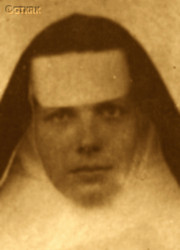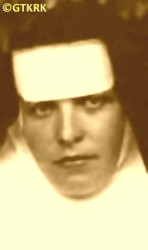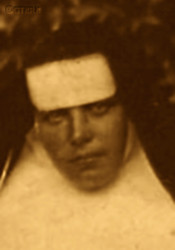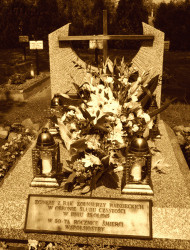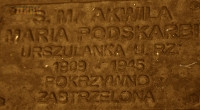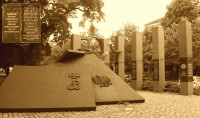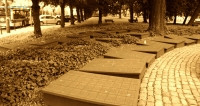Roman Catholic
St Sigismund parish
05-507 Słomczyn
85 Wiślana Str.
Konstancin deanery
Warsaw archdiocese, Poland
full list:
displayClick to display full list

searchClick to search full list by categories
wyświetlKliknij by wyświetlić pełną listę po polsku

szukajKliknij by przeszukać listę wg kategorii po polsku

Martyrology of the clergy — Poland
XX century (1914 – 1989)
personal data
religious status
Servant of God
surname
PODSKARBI
forename(s)
Mary (pl. Maria)
religious forename(s)
Mary Aquillah of Holy Trinity (pl. Maria Akwila od Świętej Trójcy)
function
nun
creed
Latin (Roman Catholic) Church RCmore on
en.wikipedia.org
[access: 2014.09.21]
congregation
Roman Union of the Order of st Ursula OSUmore on
en.wikipedia.org
[access: 2013.05.19]
(i.e. Ursulines)
date and place
of death
25.01.1945

PoznańPokrzywno, part of Krzesiny‐Pokrzywno‐Garaszewo neighborhood
form.: village
today: Poznań city pov., Greater Poland voiv., Poland
more on
en.wikipedia.org
[access: 2021.07.18]
details of death
After German and Russian invasions of Poland in 09.1939, and start of World War II, after the start of the German occupation, the nuns were expelled by the Germans from their monastery in Pokrzywno (acquired in 1924/1925). In the monastery building the Germans initially organized the seat of the German youth Hitlerjugend and an orphanage (Germ. Kinderheim), and then a tuberculosis hospital.
The nuns lived in the farm buildings and were forced to slave in the fields and on the farm, and servicing the German users of the monastery. Germans prevented the chaplain to spiritually lead the nuns, services with the priest were forbidden, and they were ordered to dress in civilian clothes.
From 1943, in the empty monastery the Germans began to prepare a place for another camp — using the slave work of c. 400 Polish prisoners. She then fell ill with tuberculosis — prob. contracted at the hospital.
On 12.01.1945, the Russian winter offensive of 1945 began, under the code name of the Vistula–Oder operation. The Russians quickly reached Poznań and on 22.01.1945 occupied the Focke–Wulf factory, along with the factory airport, in Krzesiny in Poznań. On the same day, they prob. captured the neighboring Pokrzywno (from 1942 within the borders of Poznań).
On 24.01.1945 the siege of Poznań began and lasted until 23.02.1945.
Meanwhile, the Russian occupation started on the territories already captured by them. And right at the beginning of the siege, she was murdered with a shot in the head by a Russian soldier — in defense of herself and her sisters who were attacked and raped. When in the evening, around 6 p.m., the nuns gathered for a joint supper, Russian soldiers burst into the house. Demanded 5 nuns. Were refused, and the nuns stated that they vowed chastity. Then started to run away.
When one of them was caught by a soldier, she ran to her, snatched her from the hands of the thug and pushed her paralyzed out of fear out through the door. The soldier caught herself then, but she knelt and hooked one arm round the table leg, with the other clutching the cross on the habit.
Soldier–thug shot her then.
On the same day, the Russians also murdered Sr Stefanie Trznadel.
cause of death
mass murder
perpetrators
Russians
sites and events
Mass rapes in 1945Click to display the description, Ribbentrop‐MolotovClick to display the description, Pius XI's encyclicalsClick to display the description
date and place
of birth
28.03.1909

Gorzyce Wielkietoday: Ostrów Wielkopolski gm., Ostrów Wielkopolski pov., Greater Poland voiv., Poland
more on
en.wikipedia.org
[access: 2021.12.18]
parents
PODSKARBI Andrew
🞲 ?, ? — 🕆 ?, ?

Francesca
🞲 ?, ? — 🕆 ?, ?
religious vows
17.07.1935 (temporary)
17.07.1938 (permanent)
positions held
till 1945
nun — Pokrzywnotoday: part of Krzesiny‐Pokrzywno‐Garaszewo neighborhood in Poznań, Poznań city pov., Greater Poland voiv., Poland
more on
en.wikipedia.org
[access: 2021.07.18] ⋄ monastery, Ursulines OSU — ministry in the laundry and on the farm
from 07.10.1932
postulate — Pokrzywnotoday: part of Krzesiny‐Pokrzywno‐Garaszewo neighborhood in Poznań, Poznań city pov., Greater Poland voiv., Poland
more on
en.wikipedia.org
[access: 2021.07.18] ⋄ monastery, Ursulines OSU
from 03.10.1931
nun — Pokrzywnotoday: part of Krzesiny‐Pokrzywno‐Garaszewo neighborhood in Poznań, Poznań city pov., Greater Poland voiv., Poland
more on
en.wikipedia.org
[access: 2021.07.18] ⋄ monastery, Ursulines OSU
others related
in death
TRZNADELClick to display biography Stephanie (Sr Caiusa Mary Mediatrix of All Graces)
sites and events
descriptions
Mass rapes in 1945: During capture in 1944‐1945 of pre‐war German territories and territories incorporated into Germany in 1939 after German invasion of Poland Russian soldiers committed mass, often multiple, rapes on mainly German, but also Polish, women. Up to 2 mln women might have been violated, from 8 to 80 or more years old. Many were murdered as a consequence. Rapes were prob. tolerated if not encouraged by Russian military and civilian NKVD commanders. (more on: en.wikipedia.orgClick to attempt to display webpage
[access: 2015.03.01])
Ribbentrop‐Molotov: Genocidal Russian‐German alliance pact between Russian leader Joseph Stalin and German leader Adolf Hitler signed on 23.08.1939 in Moscow by respective foreign ministers, Mr. Vyacheslav Molotov for Russia and Joachim von Ribbentrop for Germany. The pact sanctioned and was the direct cause of joint Russian and German invasion of Poland and the outbreak of the World War II in 09.1939. In a political sense, the pact was an attempt to restore the status quo ante before 1914, with one exception, namely the „commercial” exchange of the so‐called „Kingdom of Poland”, which in 1914 was part of the Russian Empire, fore Eastern Galicia (today's western Ukraine), in 1914 belonging to the Austro‐Hungarian Empire. Galicia, including Lviv, was to be taken over by the Russians, the „Kingdom of Poland” — under the name of the General Governorate — Germany. The resultant „war was one of the greatest calamities and dramas of humanity in history, for two atheistic and anti‐Christian ideologies — national and international socialism — rejected God and His fifth Decalogue commandment: Thou shall not kill!” (Abp Stanislav Gądecki, 01.09.2019). The decisions taken — backed up by the betrayal of the formal allies of Poland, France and Germany, which on 12.09.1939, at a joint conference in Abbeville, decided not to provide aid to attacked Poland and not to take military action against Germany (a clear breach of treaty obligations with Poland) — were on 28.09.1939 slightly altered and made more precise when a treaty on „German‐Russian boundaries and friendship” was agreed by the same murderous signatories. One of its findings was establishment of spheres of influence in Central and Eastern Europe and in consequence IV partition of Poland. In one of its secret annexes agreed, that: „the Signatories will not tolerate on its respective territories any Polish propaganda that affects the territory of the other Side. On their respective territories they will suppress all such propaganda and inform each other of the measures taken to accomplish it”. The agreements resulted in a series of meeting between two genocidal organization representing both sides — German Gestapo and Russian NKVD when coordination of efforts to exterminate Polish intelligentsia and Polish leading classes (in Germany called «Intelligenzaktion», in Russia took the form of Katyń massacres) where discussed. Resulted in deaths of hundreds of thousands of Polish intelligentsia, including thousands of priests presented here, and tens of millions of ordinary people,. The results of this Russian‐German pact lasted till 1989 and are still in evidence even today. (more on: en.wikipedia.orgClick to attempt to display webpage
[access: 2015.09.30])
Pius XI's encyclicals: Facing the creation of two totalitarian systems in Europe, which seemed to compete with each other, though there were more similarities than contradictions between them, Pope Pius XI issued in 03.1937 (within 5 days) two encyclicals. In the „Mit brennender Sorge” (Eng. „With Burning Concern”) published on 14.03.1938, condemned the national socialism prevailing in Germany. The Pope wrote: „Whoever, following the old Germanic‐pre‐Christian beliefs, puts various impersonal fate in the place of a personal God, denies the wisdom of God and Providence […], whoever exalts earthly values: race or nation, or state, or state system, representatives of state power or other fundamental values of human society, […] and makes them the highest standard of all values, including religious ones, and idolizes them, this one […] is far from true faith in God and from a worldview corresponding to such faith”. On 19.03.1937, published „Divini Redemptoris” (Eng. „Divine Redeemer”), in which criticized Russian communism, dialectical materialism and the class struggle theory. The Pope wrote: „Communism deprives man of freedom, and therefore the spiritual basis of all life norms. It deprives the human person of all his dignity and any moral support with which he could resist the onslaught of blind passions […] This is the new gospel that Bolshevik and godless communism preaches as a message of salvation and redemption of humanity”… Pius XI demanded that the established human law be subjected to the natural law of God , recommended the implementation of the ideal of a Christian state and society, and called on Catholics to resist. Two years later, National Socialist Germany and Communist Russia came together and started World War II. (more on: www.vatican.vaClick to attempt to display webpage
[access: 2023.05.28], www.vatican.vaClick to attempt to display webpage
[access: 2023.05.28])
sources
personal:
www.osu.plClick to attempt to display webpage
[access: 2015.04.18]
bibliographical:
„Martyrology of the Polish Roman Catholic clergy under nazi occupation in 1939‐1945”, Victor Jacewicz, John Woś, vol. I‐V, Warsaw Theological Academy, 1977‐1981
original images:
www.osu.plClick to attempt to display webpage
[access: 2015.04.18], ursulines-roman-union.orgClick to attempt to display webpage
[access: 2025.02.11], www.osu.plClick to attempt to display webpage
[access: 2015.04.18], billiongraves.comClick to attempt to display webpage
[access: 2022.04.12], www.osu.plClick to attempt to display webpage
[access: 2015.04.18]
LETTER to CUSTODIAN/ADMINISTRATOR
If you have an Email client on your communicator/computer — such as Mozilla Thunderbird, Windows Mail or Microsoft Outlook, described at WikipediaPatrz:
en.wikipedia.org, among others — try the link below, please:
LETTER to CUSTODIAN/ADMINISTRATORClick and try to call your own Email client
If however you do not run such a client or the above link is not active please send an email to the Custodian/Administrator using your account — in your customary email/correspondence engine — at the following address:

giving the following as the subject:
MARTYROLOGY: PODSKARBI Mary
To return to the biography press below:
 Click to return to biography
Click to return to biography








